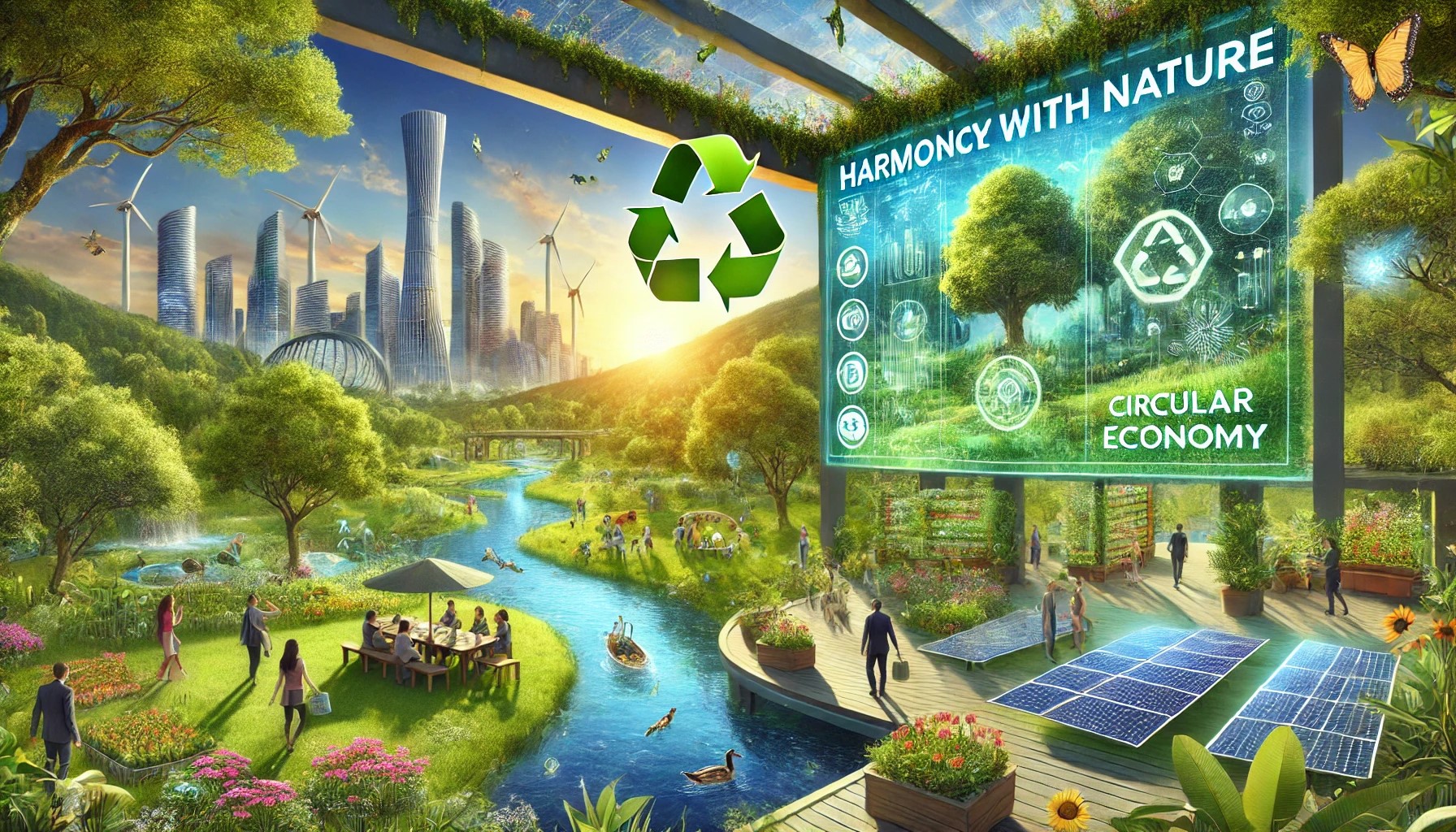— From “More” to “Better,” Building a Symbiotic Path with Nature
Introduction
Imagine walking through a lush green forest, sunlight dappling through the leaves, and the air filled with the fresh scent of earth and foliage. You feel a profound sense of peace and contentment. This vision of harmonious coexistence between humanity and nature is not merely poetic but a key aspect of the envisioned future in a Combenistic Society.
1. Oneness of All Living Beings: The Profound Connection of Earth’s Ecology
1.1 The Power of Harmonious Coexistence
Earth is an interconnected living organism, where every tree, animal, and grain of sand plays an indispensable role in its life network. Forests, rivers, and biodiversity maintain ecological balance while providing humans with a healthy and harmonious living environment.
1.2 How Harmony Nurtures Human Happiness
Human happiness is deeply intertwined with Earth’s health. Nature not only supports humanity’s material needs but also nourishes our minds and spirits. By embracing and practicing the principle of “oneness of all living beings,” humans and nature can form a mutually enriching and fulfilling relationship, bringing peace and contentment in clean air, pure water, and a serene environment.
2. The Challenges of Traditional Economic Growth: Destruction and Exploitation
2.1 Ecological Crisis Fueled by Greed
Traditional economic growth models often prioritize “more and faster” at the cost of resource overuse and environmental destruction. Large-scale deforestation, industrial pollution of rivers, and overextraction of land have drained Earth’s vitality, with humanity ultimately suffering the consequences.
2.2 The Endless Trap of Desire
In the relentless pursuit of economic metrics, humanity has often overlooked its intrinsic connection to nature. Many so-called “needs” are merely fabricated demands, shaped by unending cycles of production and consumerism. Caught in a web of comparison, vanity, and anxiety, people forget that genuine happiness does not depend on accumulating material wealth but instead risks falling into an endless pit of unsatisfied desires.
3. Overproduction and Imaginary Needs: An Unavoidable Cost
When societies chase high-intensity labor and mass production, the apparent prosperity in economic data obscures our true needs and happiness.
3.1 Consequences of High Consumption and Pollution
Overproduction leads to excessive consumption and pollution, wasting resources and contaminating the environment. Mountains of waste, deteriorating air quality, and diminishing clean water supplies are tangible signs of this imbalance.
3.2 Deep Damage to Ecosystems
Overproduction to meet fabricated demands not only pollutes but profoundly harms Earth’s ecosystems. Rivers lose vitality, land becomes deserts, and biodiversity diminishes—all of which ultimately threaten humanity’s health and safety.
4. Green Circular Economy: Restoring Rationality and Quality to Growth
4.1 The Wisdom of a Circular Economy
Confronted with the paradox of “ecological deficit” versus “economic growth,” a green circular economy offers a sustainable third way. It emphasizes efficiency and resource reuse, reducing environmental harm and fostering a virtuous cycle between the economy and nature.
- Resource Recycling: Promoting resource recovery and reuse to minimize waste and pollution.
- Clean Energy: Transitioning to renewable energy sources like solar and wind to reduce dependency on fossil fuels.
4.2 Reducing Desire and Enhancing Happiness
By curbing excessive reliance on material consumption, moderate living and spiritual fulfillment become guiding principles. A green economy ensures ecological balance and allows people to find deeper satisfaction, peace, and happiness in a world of quality over quantity.
5. Real Needs: Returning to Authenticity, Redefining Happiness
5.1 The Real Meaning of Basic Needs
Human fundamental needs are not overly complex:
- Clothing: Comfortable and eco-friendly, rather than blindly luxurious.
- Food: Healthy and moderate, avoiding extravagance and waste.
- Housing: Safe and livable, without ostentatious comparisons.
- Transportation: Convenient and green, reducing energy consumption and emissions.
5.2 Enhancing Happiness and Social Well-being
When economic development refocuses on these basic needs, resource waste diminishes, and individuals experience genuine stability and satisfaction. Rational consumption and precise production lead to more efficient resource allocation, elevating both personal happiness and public health at a societal level.
6. Balanced Ecology and the Combenistic Society: The Foundation of a Happy Life
6.1 Harmony Between Humans and Nature
The Combenistic Society centers on “ecological balance, high-quality environments, and green circular economy.” It aspires to restore natural ecosystems while enabling more people to enjoy clean water, fresh air, and healthy lifestyles. Humans and nature mutually sustain each other within the framework of a circular economy, moving away from blind exploitation and destruction.
6.2 The Basis for a Happy Life
When clean air and pure water become universal rights, the deep bond between humans and nature can be rebuilt. As ecological conditions improve, people find solace, and happiness thrives alongside prosperity, allowing everyone to share in the beauty of nature.
Conclusion: From “More” to “Better,” Toward Symbiosis with Nature
The principle of “oneness of all living beings” reminds us that every leaf and drop of water is inseparable from our lives. The green circular economy is not just about protecting Earth; it is also a pathway to high-quality development. By shedding blind pursuit of fabricated needs, we gain a deeper understanding of happiness and help society progress from “more” to “better.”
Let us unite for Earth’s future, building a Combenistic Society where humanity and nature coexist in harmony. Together, we can make green the foundation of happiness, preserving vitality for tomorrow and fostering hope for generations to come.
绿色可循环经济:回归自然与本真,重塑共益社会的幸福未来
——从“更多”到“更好”,构建人与自然共生的生态之道
引言
当你行走在一片绿意盎然的林间,阳光在树影间斑驳洒落,清新的空气中带着泥土与草木的芬芳,你或许会感受到内心的平静和满足。这种人与自然和谐共生的画面,不仅是一种诗意的栖居,更是“共益社会”所描绘的未来愿景。
一、万物一体:地球生态的深刻联系
1. 和谐共生的力量
地球是一个完整的生命共同体,每一棵树、每一只动物、每一粒尘埃都在生命网络中发挥着不可或缺的作用。森林、河流与动植物之间的相互依存,维系了生态平衡,也为人类提供了健康、祥和的生活环境。
2. 和谐滋养人类的幸福
人类的幸福与地球的健康息息相关。大自然不仅给予人类物质支持,也让我们的身心得以休憩与滋养。唯有真正理解并践行“万物一体”的理念,人与自然才能形成相互滋养、彼此成就的关系,在清新的空气、洁净的水源和宜人的环境中,收获内在的平静与满足。
二、传统经济增长的困境:破坏与掠夺
1. 贪欲带来的生态危机
传统经济增长模式常常追求“更多、更快”的数字增量,导致资源过度消耗与环境破坏。大规模砍伐森林、工业排放污染河流、土地过度开采等行为,将地球的健康透支得所剩无几,最终受到伤害的也是人类自己。
2. 永无止境的欲望陷阱
人类在对经济数据的狂热追逐中,往往忽视了人与自然的本质关联。许多所谓的需求不过是“伪需求”,被无休止地制造与刺激消费所塑造。人们在攀比、虚荣与焦虑中迷失,忽视了真正的幸福不一定依赖“物质越多越好”,反而可能让我们陷入无底的欲望泥沼。
三、过度生产与虚幻需求:不可忽视的代价
当社会一味追求高强度劳动与海量生产,我们在数据层面看似获得繁荣,实则遮蔽了内心的真实需求与幸福感。
1. 高消耗与高污染的后果
过度生产造成的高消耗与高污染,不仅浪费了大量资源,还污染了环境,带来垃圾成堆、空气恶化、水源短缺等生态难题。
2. 对生态系统的深度伤害
为满足虚幻消费需求而过度生产,不仅造成环境污染,更对地球生态系统造成深度伤害:河流失去生机、土地化为荒漠、生物多样性不断丧失……最终,这一切都将反噬人类的健康与安全。
四、绿色可循环经济:让增长回归理性与品质
1. 可循环经济的智慧
面对“生态赤字”与“经济增长”的悖论,绿色可循环经济成为了真正意义上的“第三条道路”。它主张高效与循环利用,通过清洁能源、再生资源和绿色制造技术,减少对环境的破坏,让经济与自然形成良性循环。
- 循环利用:大力推动资源回收、再利用,减少垃圾与污染排放。
- 清洁能源:推广太阳能、风能等可再生能源,缓解对化石能源的依赖。
2. 减少欲望,提升幸福
当我们摆脱对物质的过度依赖,适度消费与精神富足将成为新的生活指引。绿色经济不仅能够保持生态系统平衡,也能让人们在少而精的物质世界中体会到更多的满足、平静与幸福。
五、真实需求:回归本真,重塑幸福
1. 基础需求的真实意义
人类真正的基础需求并不复杂:
- 衣:追求舒适与环保,而非盲目的奢华;
- 食:倡导健康与节制,而非铺张浪费;
- 住:重视安全宜居,而非华丽空洞的攀比;
- 行:推行便捷与绿色,而非高耗能、高排放的出行方式。
2. 提升幸福与社会福利
让经济发展回归这些基本需求,不仅能减少资源浪费,还能让人们切实感受到身心的安定与满足。当消费回归理性、生产适度而精良,资源配置也将更高效地用于真正的社会民生,整体社会的公共福利与健康状况也会得到显著提升。
六、平衡生态与共益社会:幸福生活的底色
1. 人与自然的和谐共存
“共益社会”以平衡生态、优质环境、绿色可循环经济为核心,希望在修复自然生态的同时,让更多人享受干净的水源、清新的空气和健康的生活方式。人与自然在循环经济中互相滋养,不再是盲目的索取与破坏。
2. 幸福生活的基础
当清洁的空气、干净的水源成为每个人都能享有的基本权利时,人与自然的深度连接也得以重建。随着生态环境的改善,人们的心灵得以安放,幸福与繁荣和谐并存,人人都能分享到自然之美。
结语:从“更多”到“更好”,迈向人与自然的共生之路
万物一体,地球上的每一片树叶、每一滴水都与我们息息相关。绿色可循环经济不仅是对地球的保护,更是我们走向高质量发展的关键途径。它让我们摆脱对虚幻需求的盲目追逐,真正理解幸福的本源,让社会从“更多”进化到“更好”。
让我们携手并肩,为地球的未来贡献力量,建设一个人与自然和谐共处的共益社会,让绿色成为幸福生活的底色,也为人类的明天保留更多的生机与希望。
